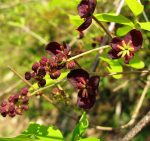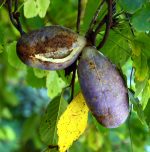 Also called chocolate vine, this semi-evergreen to deciduous woody climber is native to rocky places in the woods and thickets of Japan, Korea and China. and is a member of the Lardizabalaceae, a small family of about 40 species. The branching stems rapidly grow up to 40′ long and trail on the ground or twine up nearby plants and structures. The palmately compound leaves have three ovate, slightly lobed leaflets and are often bronze-tinted when young. Short pendulant racemes of dark purple cup-shaped female and smaller male flowers appear on the same plant in mid spring and are followed in the fall by light purple, sausage-shaped fruits up to 3″ long that are edible and can be made into jelly. Fruit production requires cross pollination. The vigorous rapid growth of the plant makes it a good choice for a ground cover and for growing on fences and other structures, especially useful for creating a screen or hiding an undesirable object. The genus name, Akebia, is the Latinized Japanese name for another species in the genus. The specific epither, trifoliate, comes from the Greek prefix tri- meaning 3, and the Latin word folia meaning leaf, and refers to the 3 lobes of the leaves.
Also called chocolate vine, this semi-evergreen to deciduous woody climber is native to rocky places in the woods and thickets of Japan, Korea and China. and is a member of the Lardizabalaceae, a small family of about 40 species. The branching stems rapidly grow up to 40′ long and trail on the ground or twine up nearby plants and structures. The palmately compound leaves have three ovate, slightly lobed leaflets and are often bronze-tinted when young. Short pendulant racemes of dark purple cup-shaped female and smaller male flowers appear on the same plant in mid spring and are followed in the fall by light purple, sausage-shaped fruits up to 3″ long that are edible and can be made into jelly. Fruit production requires cross pollination. The vigorous rapid growth of the plant makes it a good choice for a ground cover and for growing on fences and other structures, especially useful for creating a screen or hiding an undesirable object. The genus name, Akebia, is the Latinized Japanese name for another species in the genus. The specific epither, trifoliate, comes from the Greek prefix tri- meaning 3, and the Latin word folia meaning leaf, and refers to the 3 lobes of the leaves.
 Type: Semi-deciduous to deciduous climber
Type: Semi-deciduous to deciduous climber
Bloom: Short pendulant racemes of dark purple, cup-shaped female and smaller male flowers on the smae plant in mid spring
Size: Up to 40′ H x 24′ W
Light: Filtered sun to part shade
Soil: Average, medium moist, well-drained
Hardiness: Zones 5-9
Care: Prune after flowering as needed; plant may be cut to the ground in late winter to control vigorous growth.
Pests and Diseases: None of significance
Propagation: Layering, soft wood cuttings in spring, semi-ripe cuttings in mid summer, root cuttings, seed (very difficult even with 30 days of cold stratification)
Outstanding Selections: ‘Deep Purple’ (very dark fruits, large leaves with wavy margins, dense compact growth)
Photo Credits: Wikimedia Commons